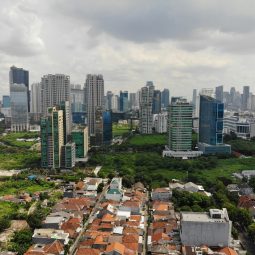In economics, demand dan supply serve as the foundation for understanding many economic concepts in life. This is because demand and supply illustrate the relationships that occur in society, simply put, like buyers and sellers toward a certain product.
Demand is the quantity of certain goods and services that are requested (purchased) at various possible price levels and within a certain period. In analysis, it is assumed that demand for a product is primarily influenced by its price level.
Therefore, in demand theory, what is mainly analyzed is the relationship between the quantity demanded of a product and the price of that product. (Sukirno, Microeconomics: Introduction to Theory, 2013). Essentially, the law of demand states that if the price of a good or service increases, then demand will decrease (ceteris paribus), and vice versa.
Meanwhile, supply refers to goods or services that are offered (sold) at a certain quantity and price level and under specific conditions. More specifically, supply indicates how much producers of a certain product are willing and able to offer per period at various price levels, assuming it remains constant.
To understand more deeply about demand and supply, it is necessary to further examine the factors that influence them.
Discover More : Pentingnya Perencanaan Pajak Dalam Manajemen Keuangan
Factors Influencing Demand

A product will have high or low demand due to several influencing factors, as follows:
1. Price of Goods or Services
Basically, the price of goods or services offered will significantly affect demand. If the quality of a product is good and the price is cheap, then it will create high demand. Conversely, if the price of the product is relatively expensive and the quality is low, then the demand for that product or service will be little.
For example, the increase in oil prices that occurred in Indonesia was caused by high demand as well as the lack of available resources, which resulted in a price increase due to the shortage between resources and needs.
2. Consumer Income
Consumer income is also a factor that can influence demand. This is because consumers are the main players in making demand, so their income becomes a benchmark for the existing demand.
Usually, consumers with high incomes tend to prioritize the quality of goods or services, while consumers with relatively lower incomes prefer the quantity of those goods or services.
In economics, goods whose demand increases as income rises are called normal goods (cars, branded clothing, travel). Conversely, goods whose demand decreases when income rises are called inferior goods (such as street food, public transportation).
3. Consumer Preferences and Tastes
Each consumer has different preferences and tastes. If a product matches the habits and preferences of consumers, then the demand for that product will increase. This means that the increase and decrease in demand are also influenced by consumer preferences for a product or service.
For example, as awareness of healthy living increases, many people prefer organic food, sugar-free drinks, and low-calorie products. This causes the demand for healthy food to increase, while the demand for fast food or carbonated drinks may decrease.
4. Price of Related Goods
Economic theory states that if the price of a substitute good decreases, then the demand for the main product usually decreases because consumers prefer the cheaper substitute. Conversely, if the price of a complementary good decreases, the demand for the main product actually increases because consumers find it easier to buy both products together.
- Substitute goods are goods that can replace another good. Therefore, if the price of a product decreases, consumers will prefer that product over another.
- Example: If the price of instant coffee drops drastically, people who usually drink tea may switch to coffee, reducing the demand for tea. Similarly, if the price of beef rises, many people will choose lamb or chicken as an alternative, increasing demand for those meats.
- Complementary goods are goods that are often used together. If the price of one product decreases, then the demand for the complementary product will usually increase.
- Example: If the price of gasoline drops, then car operating costs will become cheaper, so more people will buy cars, increasing car demand. However, if the price of printers is low but the price of printer ink rises drastically, then the demand for printers may decrease because consumers know that they have to spend high costs to buy ink.
5. Consumer Expectations About the Future
Consumer expectations about the future also influence demand. This happens because consumers tend to be aware of the potential of a product or service that will happen and project that.
For example, if there is news that house prices will rise next year due to government policies, many people will buy houses now to avoid higher prices in the future. This proves that consumers tend to think about the future before making that demand or purchase.
6. Population Size and Demographics
The population size is also a factor in demand. This means that the greater the number of people in an area, the higher the demand that will arise for certain goods and services.
Meanwhile, demographics also have an important influence because they determine who will buy a product or service. Changes in demographic structure (for example, an increase in the number of young people or the elderly) will change the demand pattern in the market.
For example, in big cities such as Jakarta and Surabaya, the number of people continues to increase due to urbanization, so the demand for apartments, online transportation, and fast food increases rapidly.
Discover More : Panduan Memahami Pentingnya Manajemen Risiko Pada Perusahaan
Factors Influencing Supply

In terms of supply, several factors also influence this economic indicator. Here are some of them:
1. Price of Goods or Services
The price of goods is the main factor influencing supply. Lower costs will trigger low supply, and conversely, if the price of the product is high in the market, then the supply of the product will increase. The increase and decrease in product prices will also affect the profit obtained from the sale of goods or services.
For example, if the price of palm oil increases in the international market, palm oil farmers will increase production because they can get higher profits. Conversely, if prices fall, they may delay harvesting or reduce the amount of production.
2. Production Costs
As a producer, production costs are also an important factor for them because higher prices can increase profit potential so that producers are more motivated to increase production. Conversely, if prices fall, producers may reduce supply or even stop producing because it is not profitable.
The total production cost can be calculated as:
Total Cost= Fixed Cost + Variable Cost
- TC (Total Cost) = Total production cost
- FC (Fixed Cost) = Fixed costs (such as factory rent, permanent employee salaries)
- VC (Variable Cost) = Variable costs (such as raw materials, electricity, labor wages based on production volume)
If TC increases, producers may reduce the quantity of goods offered due to higher production costs.
For example, in 2018, the weakening of the Indonesian Rupiah against the US Dollar caused import prices to rise, making some industries in the electronics and automotive sectors in Indonesia reduce production because costs increased and supply decreased.
3. Technology
Technology is one of the factors that has recently continued to develop and influence supply. Technological advances can certainly increase the production of a product and increase the supply of certain products.
Automation and computerization of production processes also make company operations more efficient and cost-effective. This will also affect pricing and the quantity of products in the market. With the development of the online business world, this factor is becoming increasingly influential.
Simply put, if technology increases, production costs will decrease, thus increasing supply. Conversely, if technology is still low, production can be slower and more expensive, thereby limiting supply.
According to Internet of Things (IoT), AI, and robotics technology in large factories can increase production efficiency by 30-50% and reduce labor costs by 20-30%.
For example, farmers used to use manual methods for planting and harvesting, so their crop production was limited. Now, with the presence of automated tractors, drone land monitoring, and genetically modified seeds (GMO), crop yields have increased significantly while costs and time have become more efficient.
4. Government Policies
One of the next factors influencing supply is government policy, which is commonly found in countries with mixed economic systems. Fiscal and industrial policies set by the government will affect the supply of a product.
For example, in the mining industry, the government imposes strict regulations on mining permits. Mining companies may reduce production or stop operations because of the difficult licensing process.
A study by the International Monetary Fund (IMF, 2022) also shows that regulations that are too strict can suppress the supply of goods, while tax incentives or subsidies can increase production.
A real example is in 2020, when the Indonesian government banned the export of nickel ore to encourage downstream industries, forcing some mining companies to adjust their operations, which caused a decrease in supply.
5. Price of Related Goods
The price of other related goods can influence the supply of a particular good, whether through its relationship as a substitute good (alternative) or complementary good (supporting).
- If the price of a substitute good increases, producers tend to shift production to other, more profitable goods.
- Conversely, if the price of a complementary good increases, producers can increase the production of related goods.
For example, when the price of palm oil rose by 30% in 2021, global soybean oil production increased by 15% because producers switched to soybean oil. This proves that if the price of a substitute good increases, producers may switch to producing another, more profitable good.
Similarly, if the price of a complementary good increases, producers tend to increase the supply of the related good.
6. Producer Expectations About the Future
Another factor influencing supply is the expectation of future prices. This aligns with producers’ projections of potential profits if they sell a product in the future at a higher price. As a result, they may reduce supply today, preferring to sell when prices rise.
A study by Mankiw (2007) in consumption theory also mentions that inflation expectations can cause producers to hold stock to sell in the future when prices are higher, reducing supply in the present.
7. Weather and Natural Factors
Weather conditions and natural factors also be considered, as they impact supply. For example, extreme weather conditions can lead to crop failures, reducing the availability of agricultural products.
This factor is often unpredictable and can significantly impact the availability of goods in a market.
For example, one of the biggest impacts was the COVID-19 pandemic in 2019, which caused the global economy to suddenly halt. The effects of this included weakened purchasing power among consumers as well as disrupted production processes, which led to a decrease in supply across industries worldwide.
Demand and supply are two essential concepts in economics that are closely related and influenced by various factors. Demand is influenced by price, consumer income, preferences, the price of related goods, future expectations, as well as population size and demographics. Meanwhile, supply is determined by price, production costs, technology, government policies, the price of related goods, producer expectations, and natural factors.
Understanding these factors is crucial for individuals, businesses, and governments in making the right economic decisions. Through in-depth and precise analysis, economic actors can optimize their strategies to face dynamic market changes.
Is your business ready to face a dynamic market? Arghajata Consulting is here to help you analyze the economic factors influencing demand and supply, as well as design the best strategies for your business growth. Contact us now and optimize your business opportunities!

















